
Having left behind the steep volcanic mountains of the Society Islands of French Polynesia for the 1400 mile westward sail to Tonga, we were startled to find that the islands of Tonga were completely geologically different. No mountains here, just limestone cliffs pushed up from the ocean floor. Almost every island has a narrow beach, if any, with a backdrop of a steep cliff to scramble up before arriving at a flat area on top of the island, similar to the shape of a California butte, except these are densely covered in jungle growth.


What is incredible about this island group is that the entire set of islands is encircled by one large reef, with only a few openings, so sailing between islands within the group is like sailing on a lake; there is virtually no swell. It is gusty, however, with the wind whipping around gaps between islands, or where the terrain is flatter. The wind speed variability makes sailing interesting! And somehow it seems that no matter which direction you are headed, you can sail. Only at the final entrance into the main Bay, might you need to douse the sails and motor, since it is a narrow passage and directly into the wind.
Unlike French Polynesia, tides make a big difference here in terms of timing your snorkeling ventures, anchoring, entering passes, etc. And don’t be fooled into thinking you can cross anywhere you see open water – there could be shallow areas and reefs hidden in those waters, which you don’t see until you are on top of them, similar in some respects to the lagoons in the Tuamotu archipelago in French Polynesia. It is a good idea to have a few different charts available at all times to double check your course.
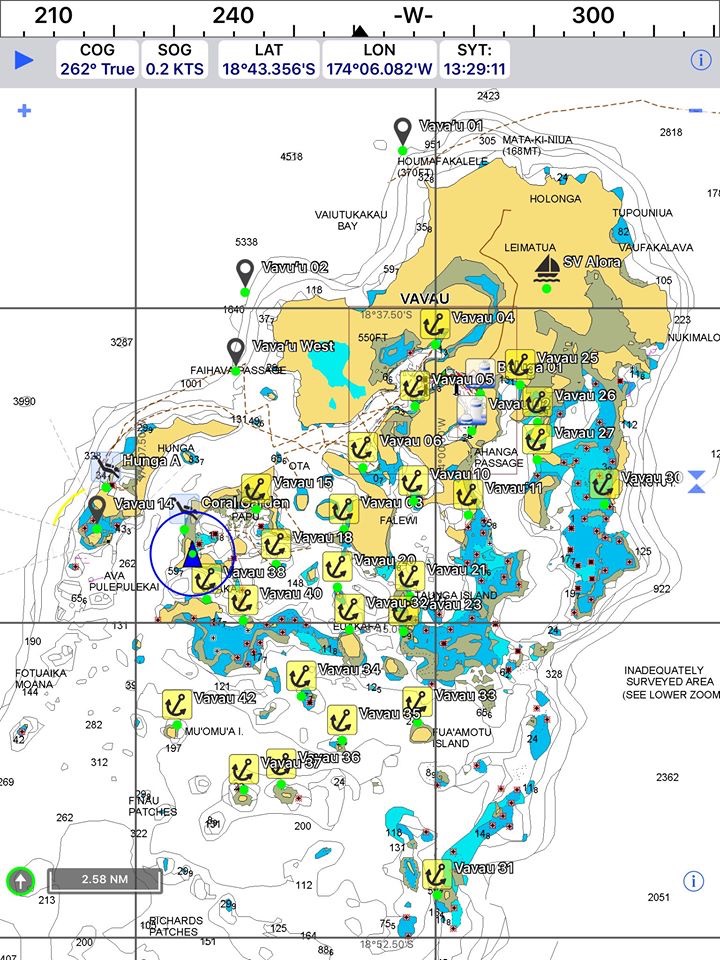
All of these anchorages to choose from, all within a few miles of each other! The Moorings charter base still operates out of Neiafu, although we get the impression that it is only a shadow of its former self; the catamarans are not well maintained and there are not many of them. But back in the day, it seems that The Moorings did all cruisers a big favor by identifying all the places in the Vava’u group where anchoring is possible, distinguishing between daytime and overnight anchorages, along with a description of the approaches and the nature of the anchorages. They even numbered all the anchorages, so the cruisers didn’t even have to learn the name of the bays! (Some of them are tongue-twisters). They have a nice chart for sale that details all of the anchorages, and their guidebook is available on certain cruiser resource websites for free. As of this writing, there were three anchorages that provided maintained moorings: the main anchorage near the town of Neiafu, Port Maurelle, and Tapana Island. Otherwise, there is good holding everywhere else. When the weather starts to look particularly rough, you can always dash back in a short day sail to the Port of Refuge Bay, in Neiafu. It is quite the cyclone hole, protected on all sides, and well into in the center of the Vava’u Group.
Dan’s Visit
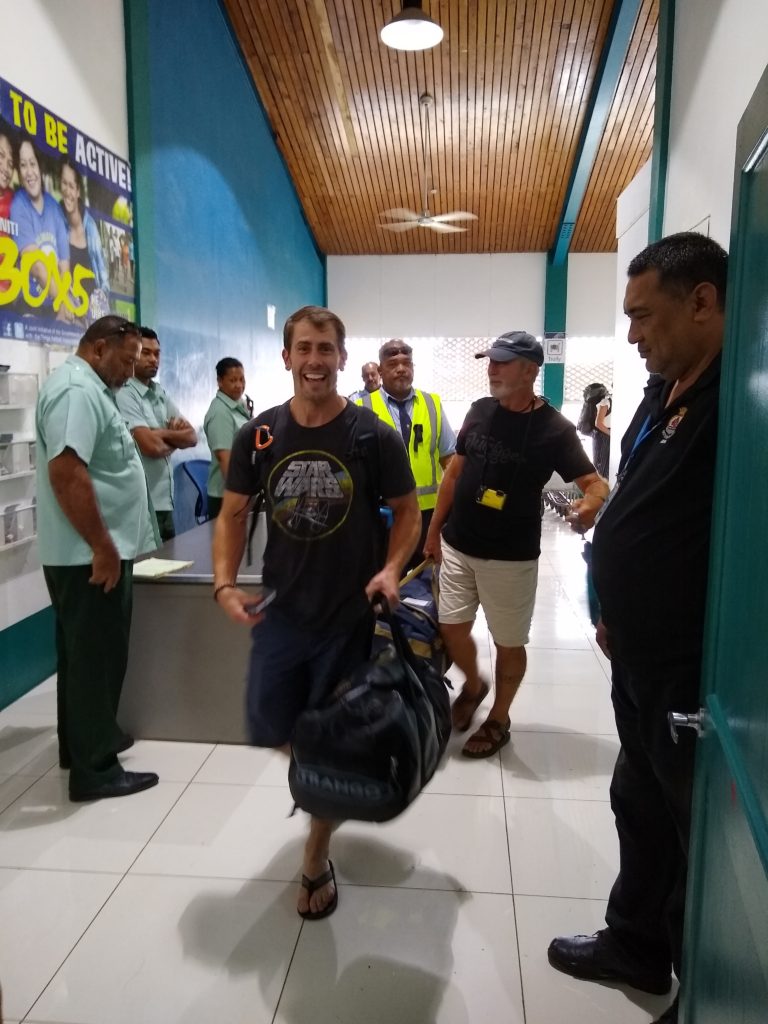
In preparation for our son Dan’s visit, Rick and I explored as many of the anchorages that we could, finally settling on six of our favorites for his ten day stay with us. They included the following:
- Port of Refuge Bay, Neiafu. This is the only anchorage you can conveniently drive to from the airport, so it was the obvious choice for our first and last night with Dan. After the B.S. we faced in Bora Bora, having to pay a fee just to land our dinghy at the Bora Bora Yacht Club, it was so refreshing to discover that the Mango Restaurant provided free dinghy tie ups to all cruisers, whether or not they were eating there.
Neiafu is the only place you can seriously provision in all of Vava’u, and it is where all of the cruiser services are located. It is “home base” when in Vava’u. At the height of the season it is sometimes difficult to get a mooring, which costs about $10 U.S. per day. Most of the moorings are owned by the a local dive shop, which is comforting! And it is the one place in Vava’u where anchoring is fairly challenging, either because it is too deep, or the bottom is bad holding. We were lucky to always eventually get a mooring, although sometimes we had to go to great lengths to find an available one.


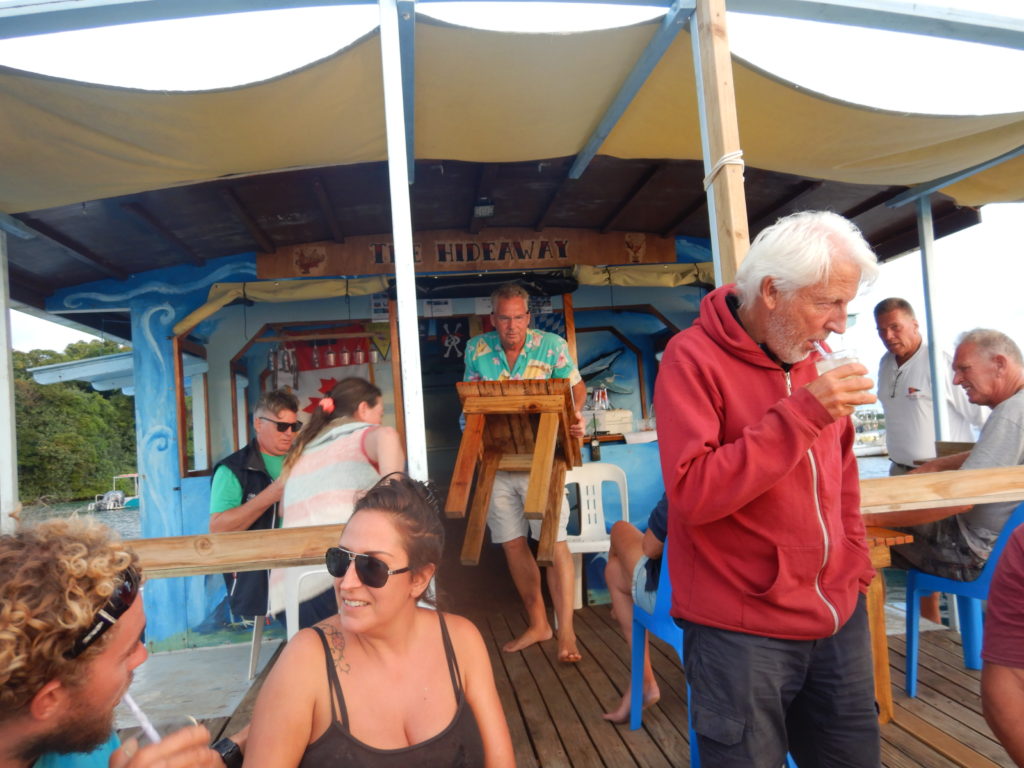
- Kenutu Island. Our second stop after Neiafu was way on the other side of the island group, about a 15 nautical mile sail, to the island of Kenutu, Anchorage #30. This is a dramatic anchorage, and getting there can be exciting too, because you have to zig zag through a narrow pass between reefs.
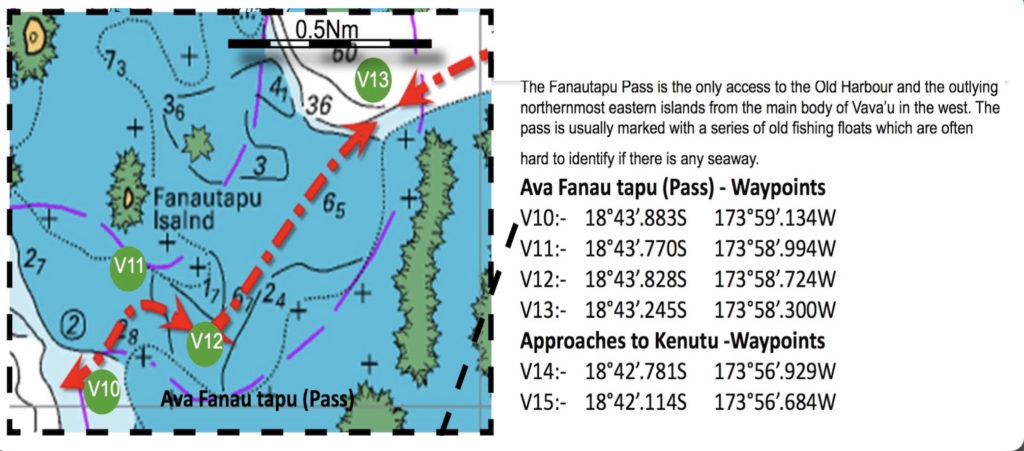
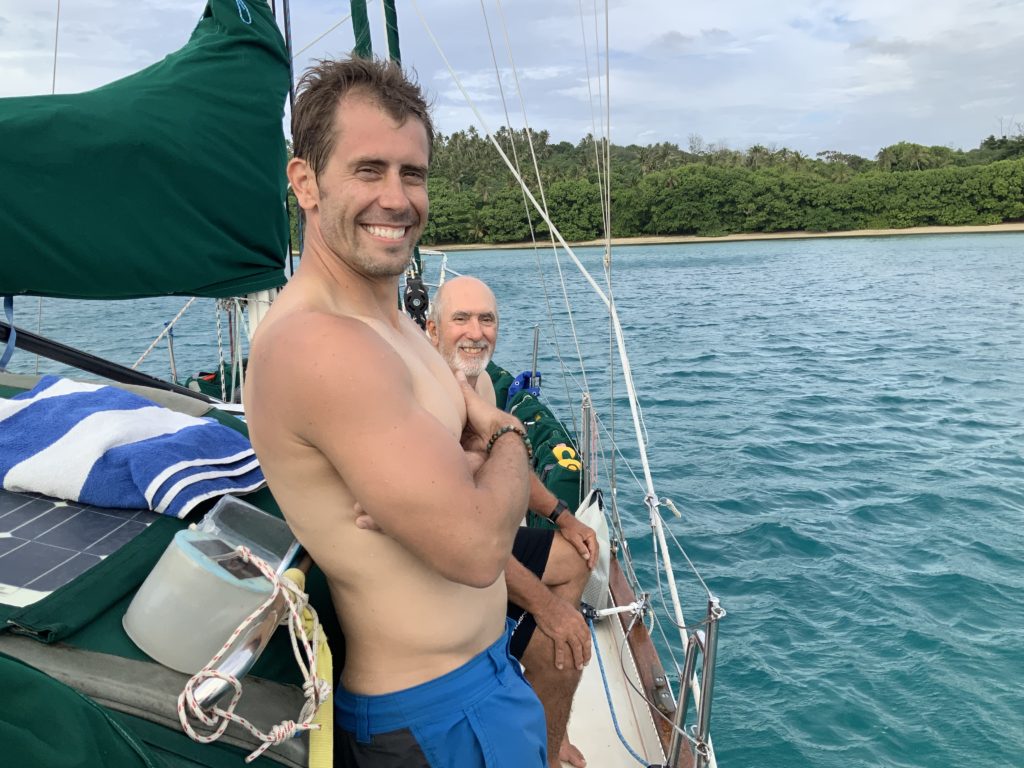
Kenutu Island is on the far eastern side of the Group. The anchorage is in the lee of the island, but the other side of the island is windswept, with the full force of the prevailing winds and currents of the South Pacific Ocean crashing onto its shores. There is a short hike up to the top of the island from the anchorage, and then you can barely make out a path through the growth along the ridge at the top of the island. Of course, we managed to stumble through, climbing over and under tree limbs and through jungle brush, with Dan charging ahead and exploring every bend with zeal.
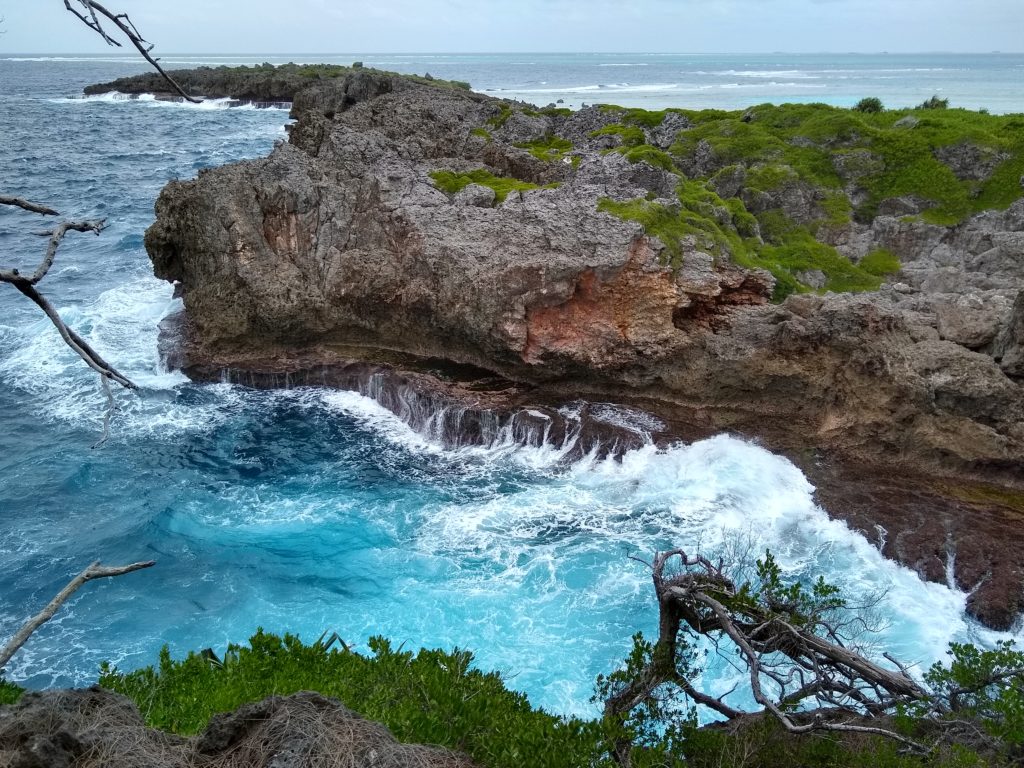
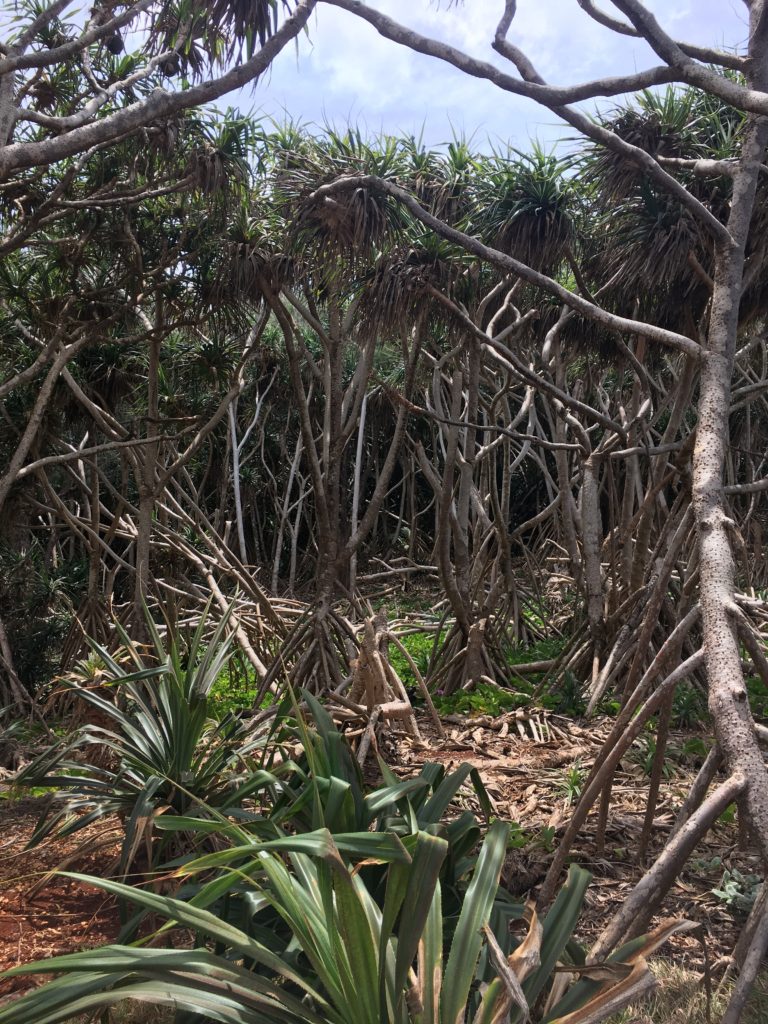

- Port Maurelle. Our next stop after Kenutu Island was Port Maurelle off of Kapa Island. This is a very popular anchorage for many reasons: it is close to Neiafu, it is well protected with good holding, it has a few reliable moorings, and it is within a dinghy ride from one of the most popular snorkeling locations, called Swallow’s Cave.
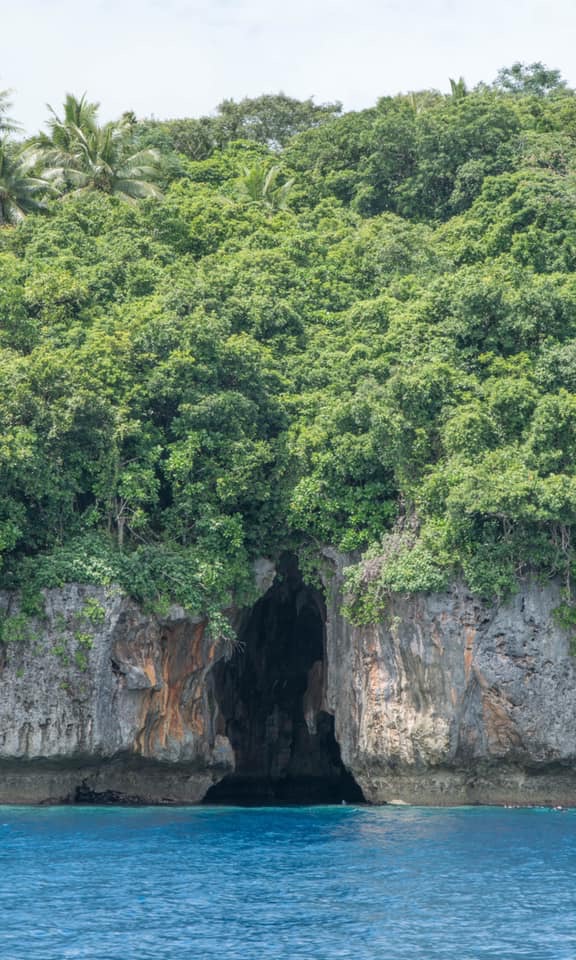
Swallow’s Cave is a huge opening in the limestone wall of an uninhabited island. The first time we went, it was magical. The afternoon light was just right to reflect through the water and spotlight the bait balls: thousands upon thousands of fish swimming in unison as though they were one organism. I have never seen anything like it in person. When we took Dan, the bait balls were gone, but he still loved it.
The cave is huge, big enough to row around inside with the dinghy.
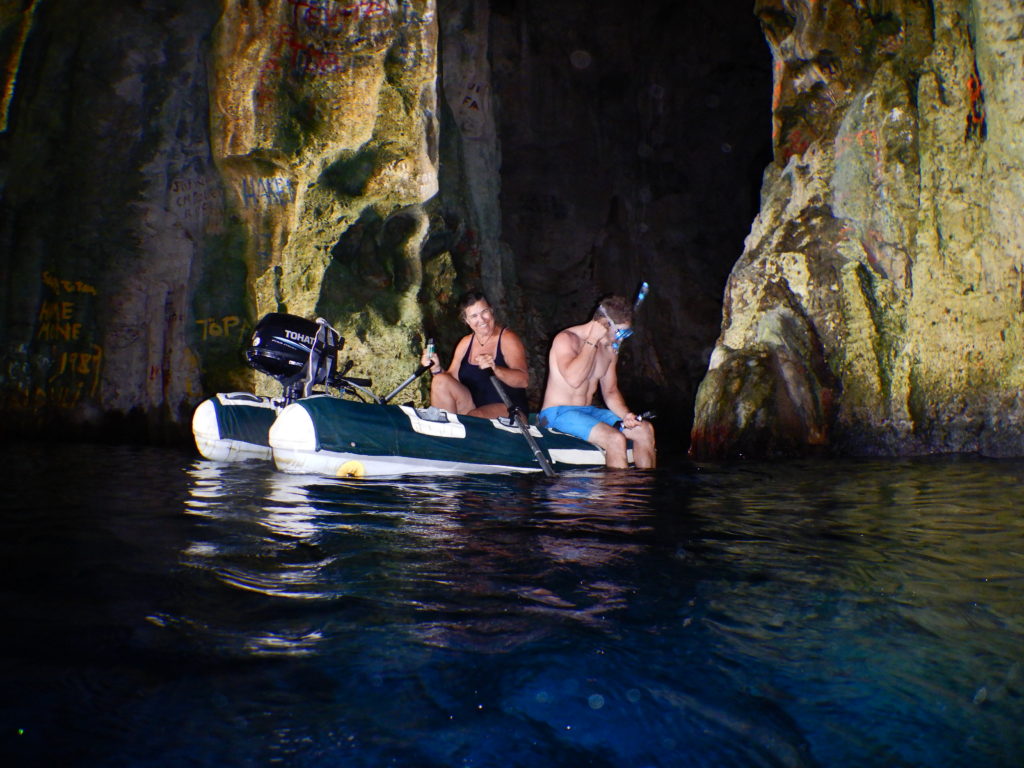
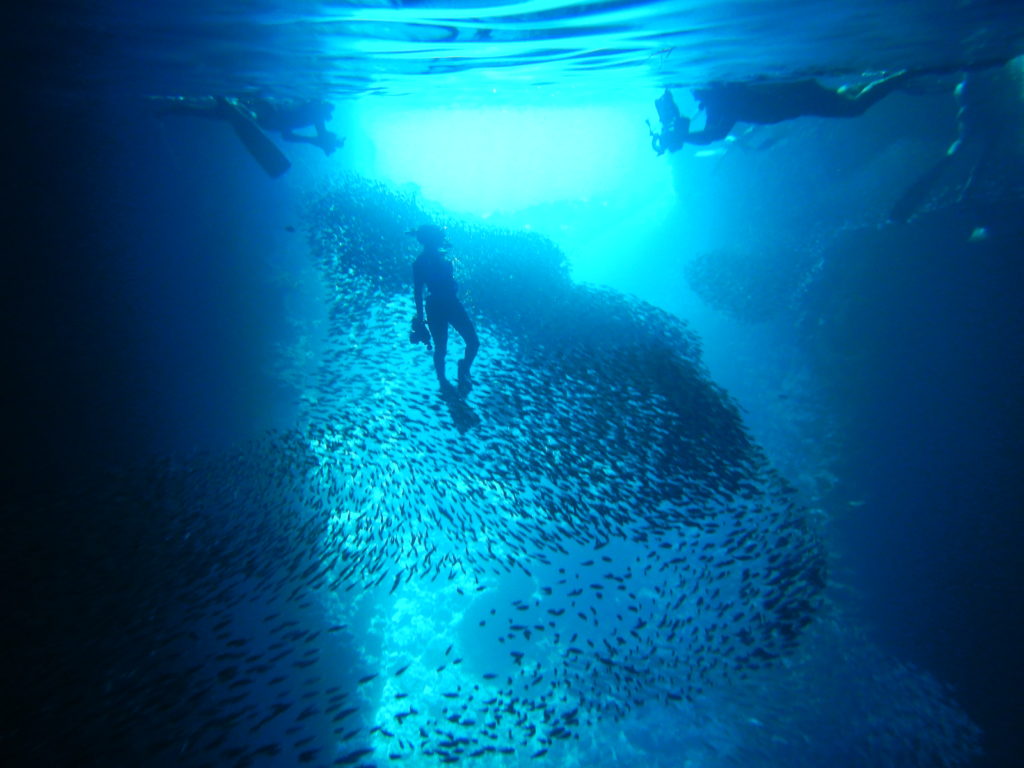

We were picked up the next day off our mooring in Port Maurelle by a commercial dive boat for a day of “swimming with the whales.” To the extent that there are any tourists in Tonga besides those who arrive by sailboat, this is what they come for – to be in the water with a humpback whale. There are very few places in the world where you can ride with a commercial boat to dive into the open ocean and swim with the whales; as we realized afterwards, it can be very dangerous! In fact, swimming with the whales without a commercial guide boat is illegal in Tonga, and there are rules about how far the boat can be from the whales and how many tourists can dive in at one time (4). Fortunately I didn’t hear until after our swims that someone had their foot bit off by a shark as they were re-entering the guide boat after a whale swim not too long before.
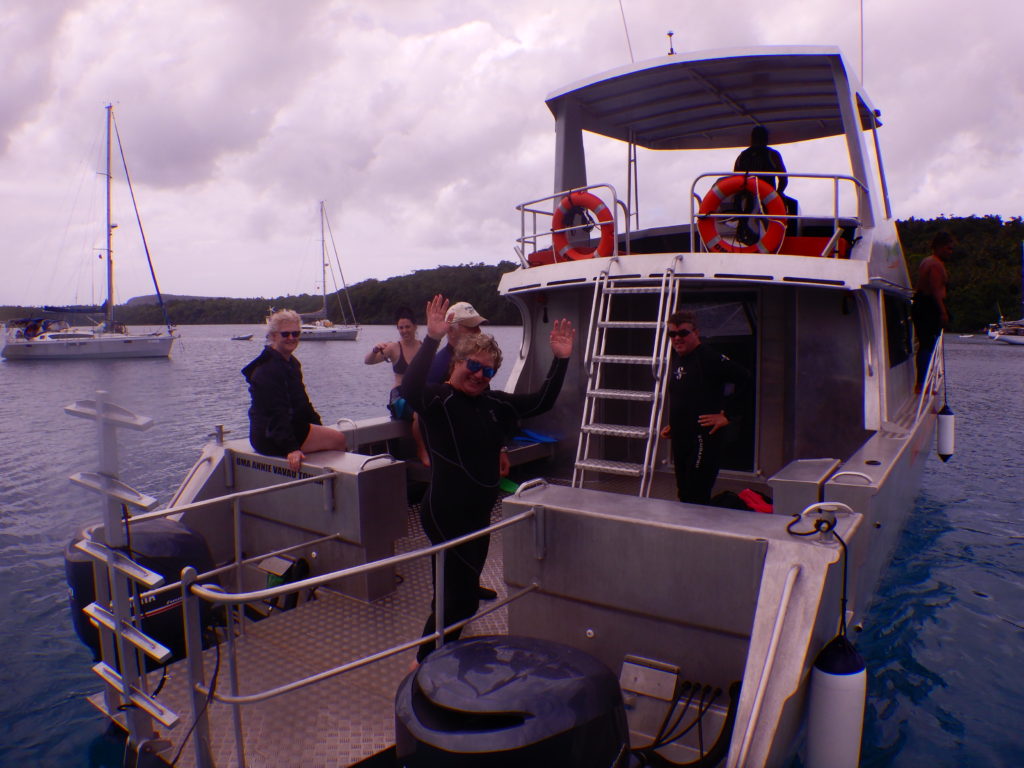
So, here’s how it went. The dive boat went outside of the perimeter of the enclosed Vava’u Group, to where the waters were deep and the swells were four to six feet. The driver charged along, looking for spouts or other signs of whale activity. When he thought he spotted something, he stopped, and our young, buff Tongan guide jumped into the sea and swam out with snorkeling gear on, in search of whales. In all cases that day, the whales were submerged approximately 30 feet under water, floating. In all cases, it was a mother and her calf, with the mother under the calf. Once he spotted the whales, four of us were encouraged to immediately jump in and swim out to the guide. We did this three times at three separate locations. As soon as we reached the guide, he checked in with each one of us to make sure we were ok. Then we lay on our tummies and searched below through our masks for the whales.
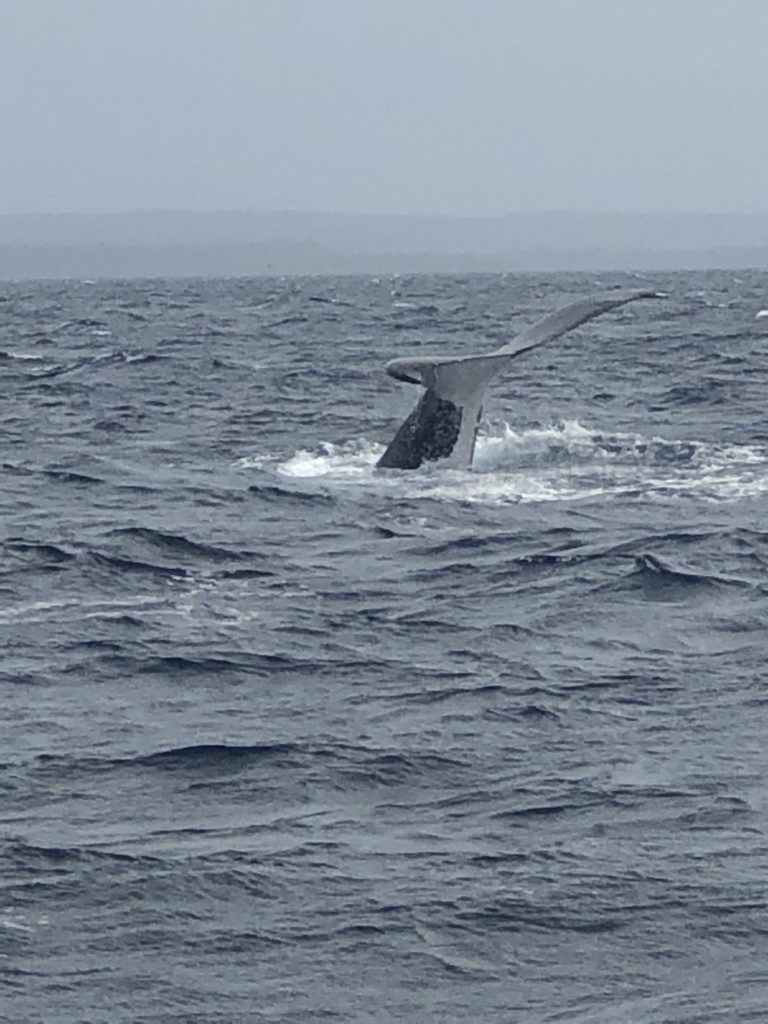
Swimming out to the guide was no easy feat for Rick and me. The guide had to hold his arm up because the swell prevented you from seeing him, and even then, you could only see him when you were at the top of a wave. So we dove in and swam like crazy through the 4 to 6 foot swells, stopping every once in a while to make sure we we’re still heading towards the guide. Rick and I quickly lost track of each other, so we really couldn’t help each other.
By the third swim, it seemed the guide was further away from the boat this time, and I think I had used up my store of energy for the day. I ran out of breath about halfway. I had to roll over onto my back, remove my snorkel and just float for a while to catch my breath. I had to fight off fear. After all, we were not using life jackets. However, I was able to return to swimming and finally made it to the group. Rick had a similar experience on an earlier swim. Had we realized in advance how much physical exertion would be required, we probably would have said that we weren’t in good enough shape to undertake this adventure. But as it was, well, there we were!
On the first swim, we floated above the two whales for what seemed like a long time, but they never surfaced. All we could see was the white on their fins and bellies. On the second swim, however, after floating above them for some time, they decided to grace us with their presence. Ever so effortlessly, they swam up to the surface, heading right for us. OMG! WTF! All of a sudden you have two several ton animals heading right for you – what do you do? Well there is really not much you can do except hope they are kind. But having a whale swim up from the deep right next to you and look you in the eye is an experience you will remember till you die.
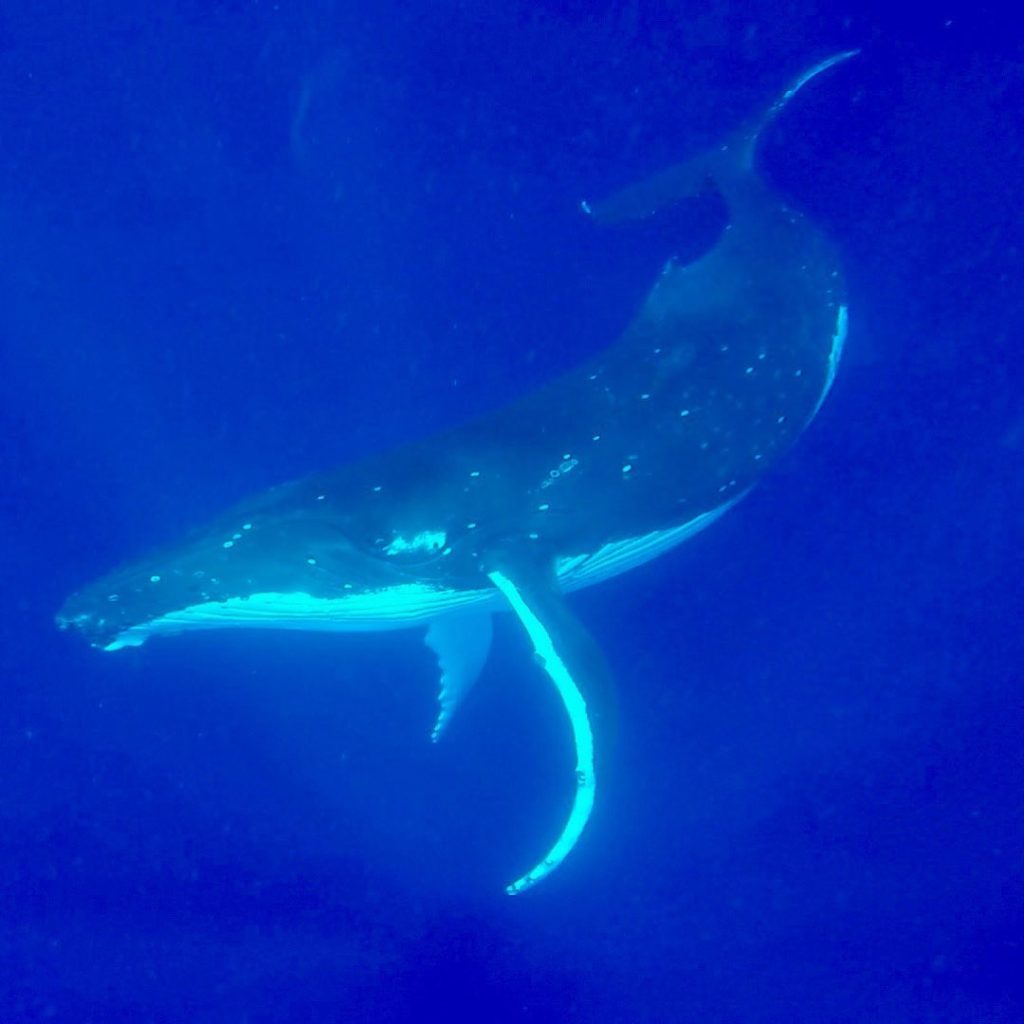
On the third swim, the same thing happened: after floating above them for a while, the mother and calf surfaced amongst us. I was a little more relaxed this time, with a little more trust that the whales were not there to hurt us, so I was able to enjoy their presence even more.
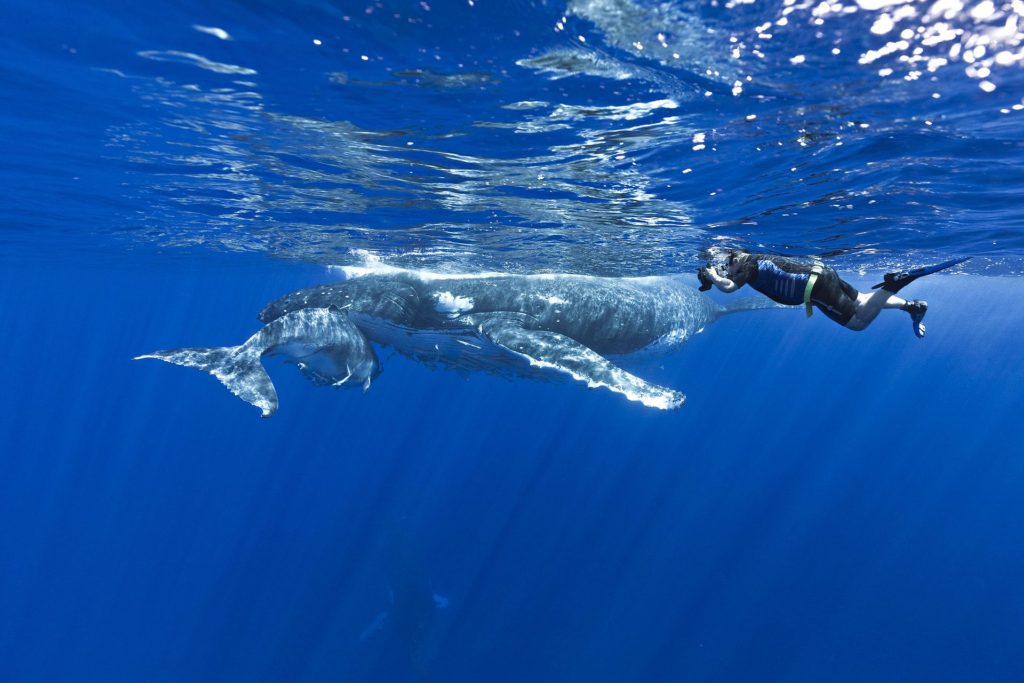
The group on our whale swimming tour were an absolute ball: two couples from the U.K. and a lovely young woman from Ireland. The U.K. couples were chartering a catamaran for the week – they get together and charter a boat, mostly to scuba dive, every year in different parts of the world. We ran into them again one night later in an anchorage and partied with them way beyond what any proper Englishman should!

- Hunga Lagoon and Blue Lagoon. The next day we sailed over to another magical place: Hunga Lagoon. Hunga Lagoon is in the caldera of an extinct volcano, at sea level. There are only three places around the ancient volcano rim’s perimeter where ocean water can enter, and only one that is deep enough for a sailboat to get through, and then only at high tide.
The trip over to Hunga was fun because you go outside the edge of the Group again to get there, and that is where the whales hang out. It was a calm day, much calmer than when we went for our swim, and the whales were all out and having fun. Rather than duck right into Hunga, we sailed further down the coast to follow a group of four whales, who came up to greet us every few minutes or so.
We spent the afternoon exploring Hunga Lagoon, and Rick and Dan went snorkeling near where our boat was moored, at a place the locals call “the truck.” It is a large bommie with lots of fish out in the middle of the lagoon.
The next day we headed over from Hunga Lagoon through a shallow pass, accessible only by dinghy at higher tide, to the Blue Lagoon. The Blue Lagoon is large but mostly quite shallow, with lots of reefs, and is surrounded by various small unpopulated islands with idyllic Sandy beaches. Rick and I set up our lounge chairs in the shade to read while Dan spent hours snorkeling from the shore.

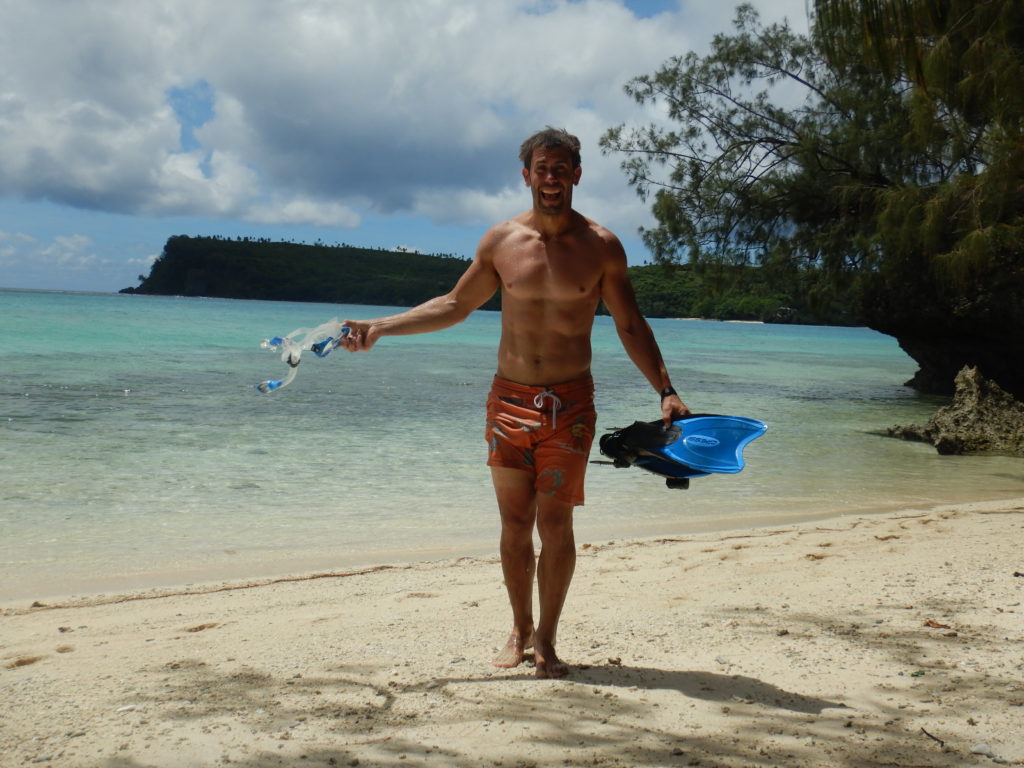
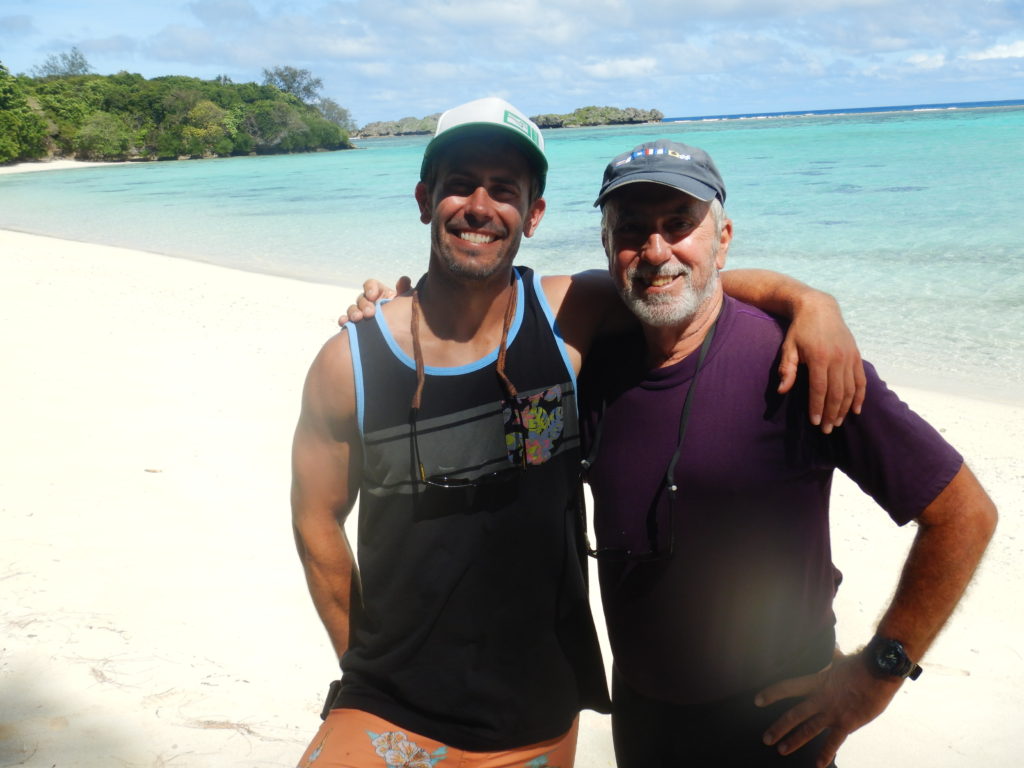
So, what is with all this snorkeling, you might ask? Over the course of our three months in Tonga, Rick and I did our share of snorkeling too, throughout the Vava’u Group. Here are some of what we saw:


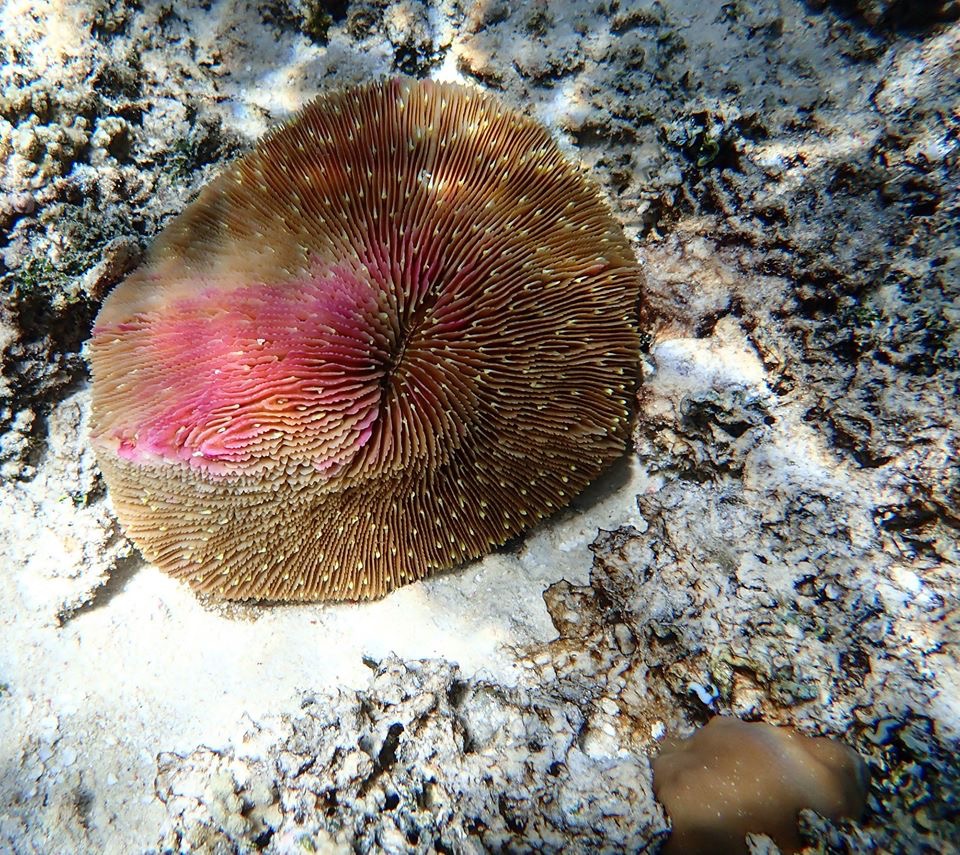




Thanks, Roy, for your great pictures! I hope Dan saw most of these himself, although due to weather we weren’t able to take him to two of our favorite snorkeling spots: a place they call the Japanese Garden, and off the tip of the peninsula on Pangiomotu Island between Lisa’s Beach and Tapana (Anchorages #10 and #11).
As we departed Hunga the next morning at high tide, we took this video. The passage is shallow and narrow!
- Tapana Island Anchorage (#11). This was our next stop after Hunga. Besides being a well protected, lovely anchorage with maintained moorings, the other attraction of the Tapana Island anchorage is the nearby Paella Restaurant. A woman named Maria and her slightly crazy husband Eduardo sailed here from Spain about 30 years ago, and stayed. They built a restaurant out of local materials up on a hill and they serve only paella and an assortment of delicious tapas, fixed menu, bring your own wine, by reservation only. The island is accessible only by boat; nevertheless, it took us three tries to find a date when they weren’t already booked to capacity! The paella is cooked over a wood stove, the server is Maria’s gradeschool-aged grandson, and Eduardo serenades the guests after dinner with an eclectic mix of Spanish ballads and folk tunes, often with the words a bit jumbled. He came out dressed in a hat and cape to sing me happy birthday:
But that adds to the fun, right? And the food and atmosphere was wonderful.
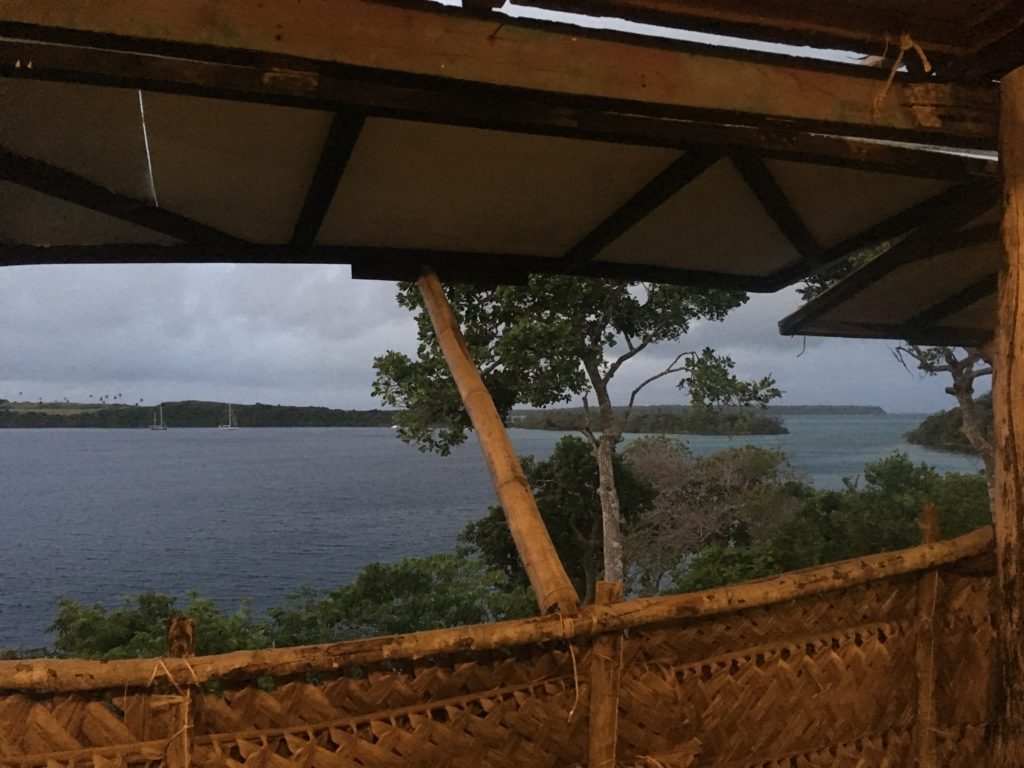



On our dinghy ride home from Maria’s, we passed by the chartered catamaran of our British friends from the whale trip. Both of our parties had started before we gathered, so we were all in fine form to continue!
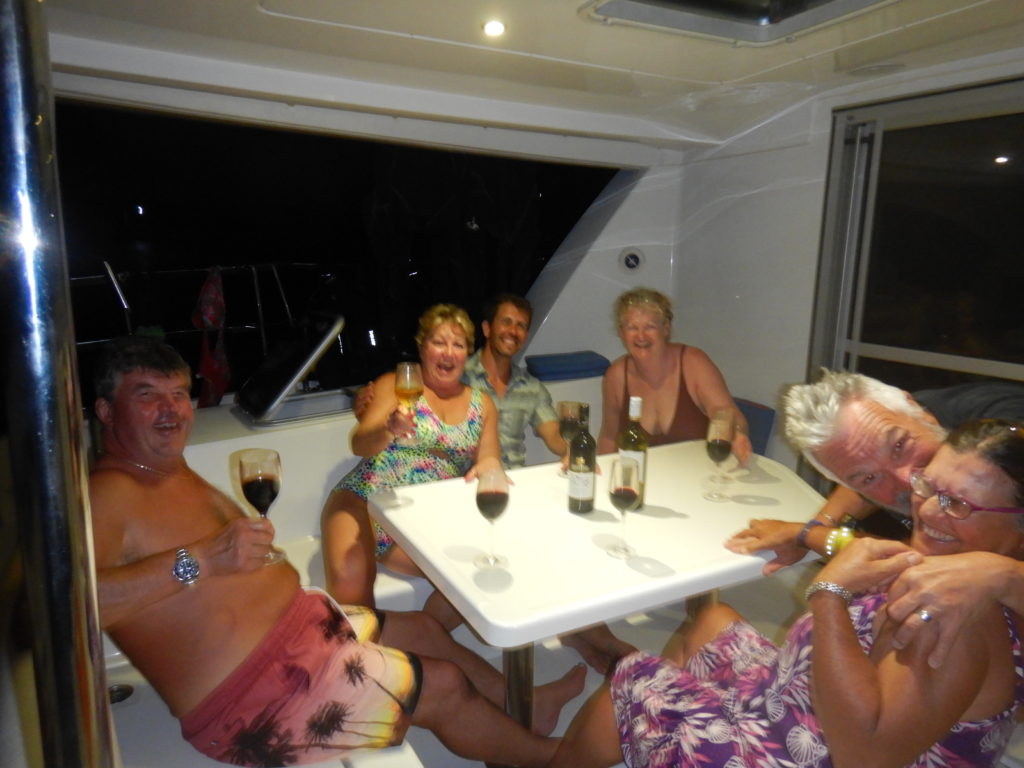
- Lisa’s Beach (Aisea Bay), Anchorage #10. For our last day before returning to Neiafu, we motored just around the corner from Tapana to Lisa’s Beach. Short of Neiafu, this is probably the most protected anchorage in all of Vava’u. The water is completely calm even when there is a storm raging around the bend. Dan took advantage of the setting to snorkel his heart out, his last opportunity until he returns to visit us next year, likely in Fiji. We had hoped to cross over to the Japanese Garden in our dinghy from here to go to a prime snorkeling location, but the open water between here and the Garden was too rough with wind waves. Dan seemed content to just swim around in this bay instead.

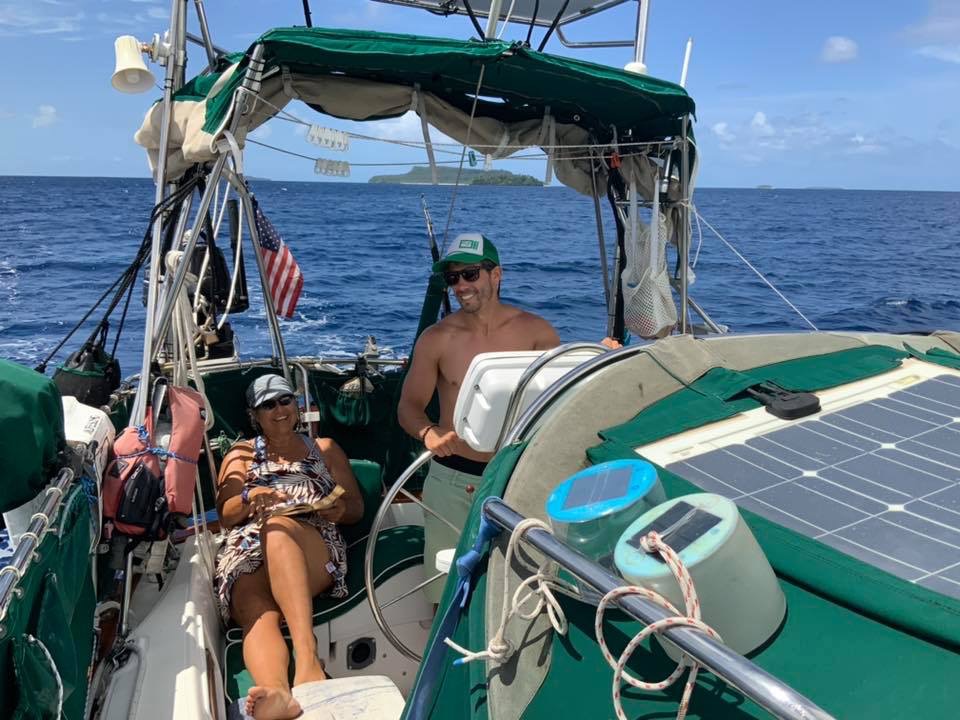
Our final stop was back in Nieafu Bay on a mooring. We had the Mango Restaurant’s scrumptious lobster dinner for our last supper, and a nice breakfast at the Tropicana cruisers hangout the next morning before we put him in a cab to the airport. He took a few moments out to run down to the market for a few souvenirs, and off he went.

Cruising Friends and Acquaintences
About 500 sailboats, more or less, cross the South Pacific Ocean from the west coast of the Americas each year. Shoot, that amounts to less families than represented by my high school graduating class! We are a small group. And less than an estimated 20% who make it as far as Tonga are from the U.S. or Canada. Some rush through in one season, while others stay as long as they can in each country. Many of us left from the same place in Mexico, or met there while cruising before our Pacific crossing. With a few variations, the route across the South Pacific is pretty much the same for all of us, and the places to stop are limited. The international check-in ports are few in each country.
We are all mostly in the same anchorages, provisioning or securing parts at the same shops, having an occasional dinner out at the same restaurants. Some of us met because we both chose to depart for a passage at the same time and searched for those we could communicate with underway, we heard each other’s voices on some local cruisers‘ radio net or another, or we just dinghied over to another boat in the same anchorage to say Hi. In some cases, we randomly carried a part back to a remote location from a visit to the U.S. for a boat we didn’t even know, or someone did the same for us. After being out cruising for over five years now, Rick and I have a fairly broad expanse of friends and acquaintances from countries all over the globe, who are all part of the small world cruising community.
Some of the folks we spent time with in Tonga this year include the following:


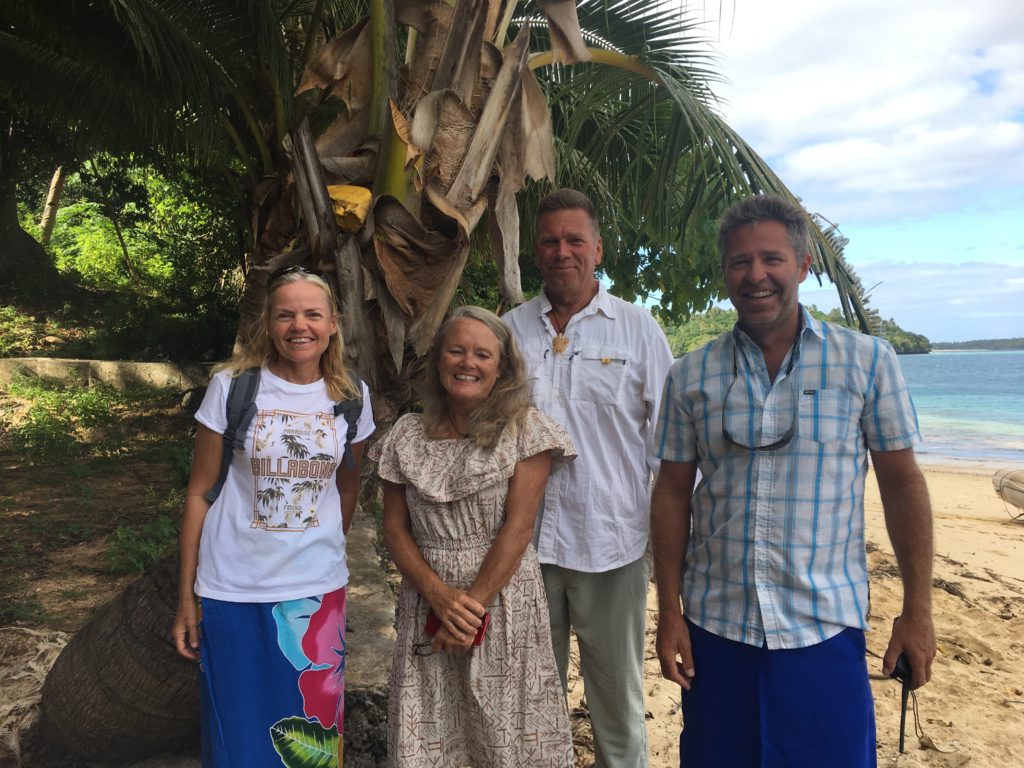

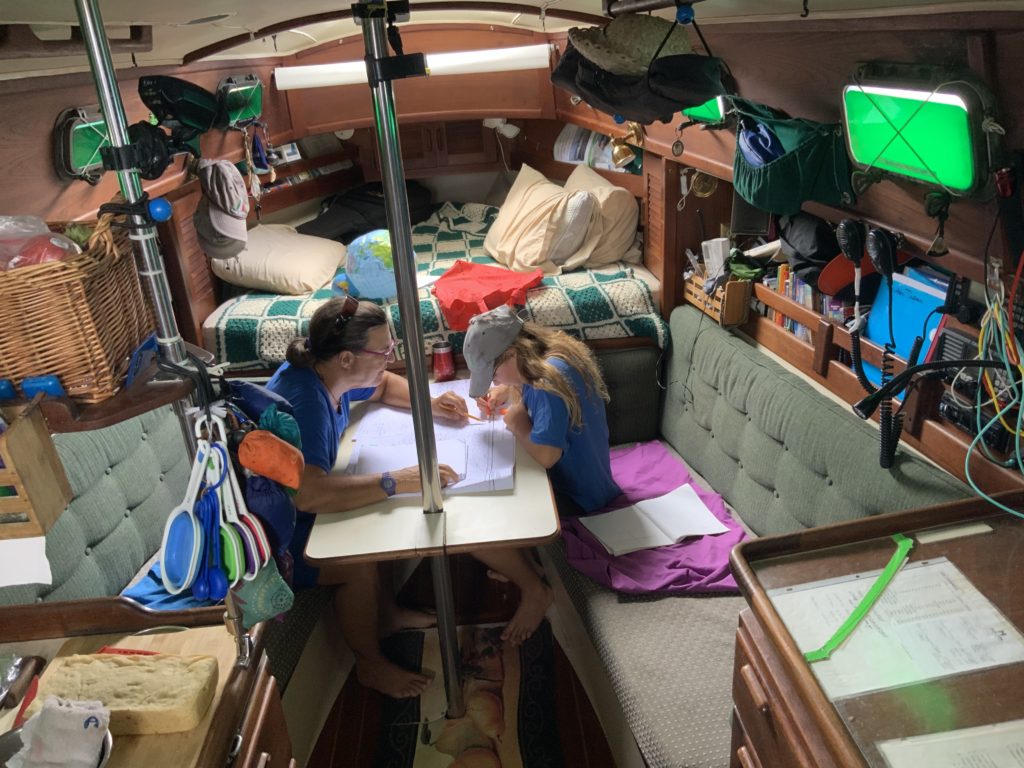


Other boats we met or reconnected with in Tonga included Kathy and Dave from s/v Manavai; Tim and Anna from Pakele Loa; Eben and Annie from Taleisin (formerly owned by Lynn and Larry Pardee, well-known old-school circumnavigators); Ava and Pajo from s/v Cinderella, an all-electric boat; Mike and Kellie from Dash, with whom we did the Pacific crossing; Janet and John from Tango; Steve and Alice from Ocean Star; Rob and Pamela and their paid crew from the Gunboat mega-catamaran Laguz, from Australia; Toby and Julie from Sunflower; Colin and Lauren from Island Pearl, from Australia; Jeff, Michelle and Sammy from Seahorse; John, Jeff and Marina from Usual Suspects; Elizabeth and Garth from Irwinish; Laurela and John from Imagination; Swedish Thor and his buddies from Lady Star 4; Jeff, Monica and their kids Anna and Sophia from Luminesce, who also crossed over from Mexico the same year we did; and Tim from Nomad. And these are just the ones we managed to remember to write down!
After the Haul Out
Once Dan left, we had one week to prepare before having Cool Change hauled out of the water and put on a secure cradle on land for cyclone season in the Vava’u Boatyard. Thank goodness we discovered this boatyard; had we not, we would have either had to sail another 2500 miles this season to Australia, or had to forego heading west from French Polynesia. The reason is that this boatyard is at 173 degrees longitude west; another seven degrees west and we would have been outside of our boat insurance’s geographical limits for the cyclone season.
We spent the week washing, drying and putting away our sails, which is a big job. We needed a hose, a continuous source of water, and little wind, for at least two sessions of several hours each. The only place we could do that was The Moorings docks, by prior appointment, and they are often busy. Many yachts forego this step, putting away their sails with salt still glued on, but our philosophy is that the sails will last longer this way, especially if they are going to be folded up and tucked away for six months.
The final day before we hauled out, we spent one last night away from the main harbor, on a mooring in front of the Tongan Beach Resort. We hung out at the resort in the afternoon and had a lovely dinner there that night. Any excuse to enjoy a special night out!
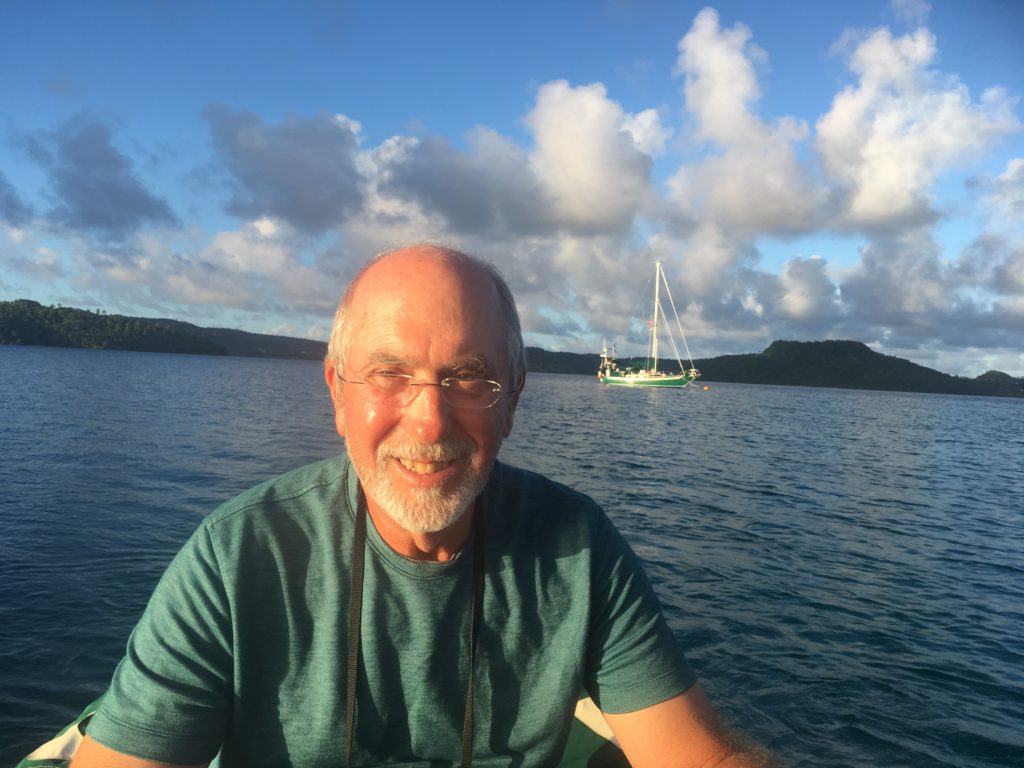

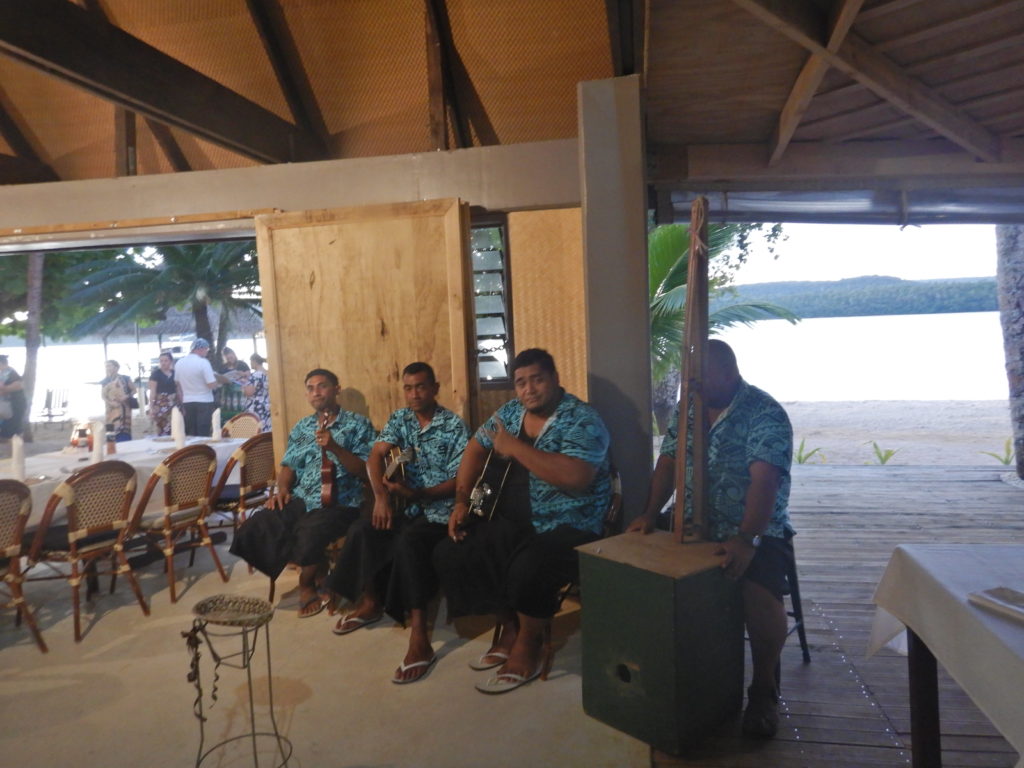
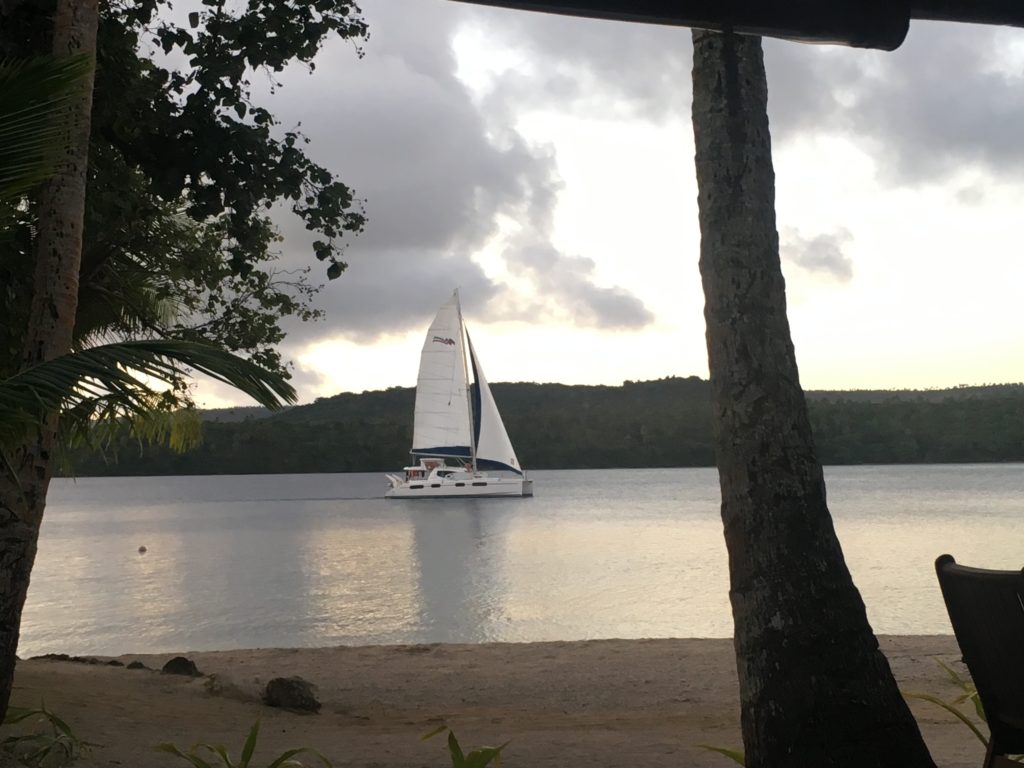
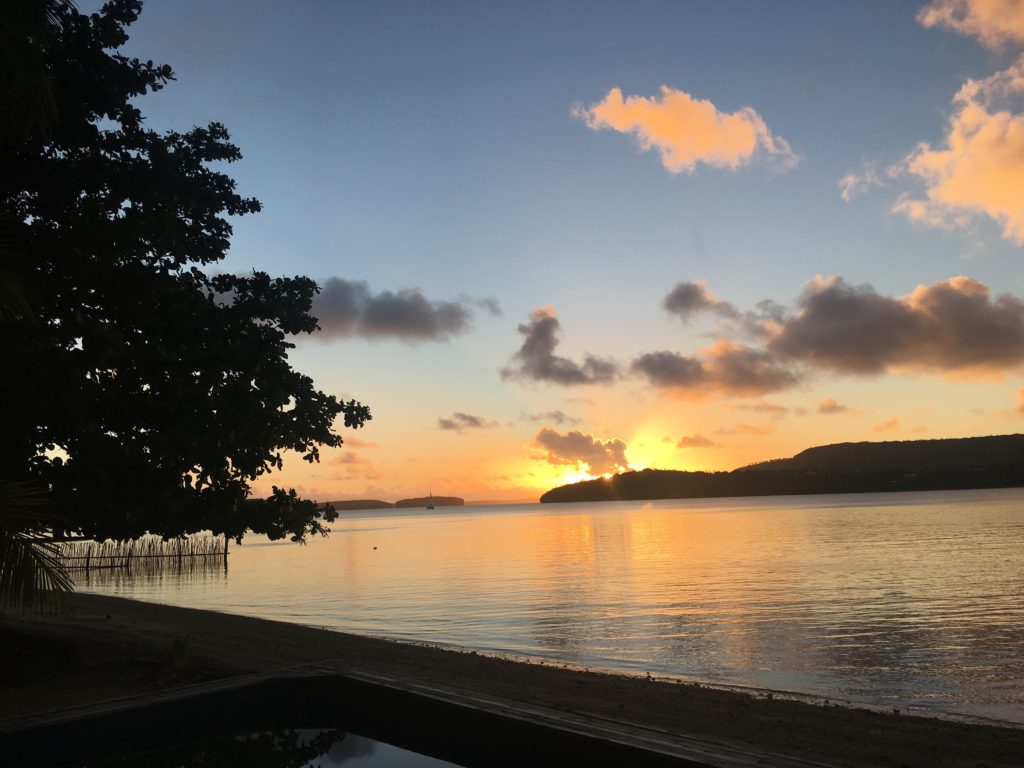
The next day, we were hauled out at the Vava’u Boatyard. Usually a machine called a “Travel Lift” drops slings under our hull while we are still in the water in a narrow slip, and then it lifts us out. But this is a relatively new boatyard with different facilities, so instead of a Travel Lift, a trailer is backed onto a ramp into the water and then we float onto it. It was a little hair-raising, but they knew what they were doing – they had lifted much bigger boats than ours with success.

We had had enough experience over the four previous years of decommissioning, including last year in Raiatea on the hard, that we knew we needed to stay somewhere besides the boat at night while decommissioning. There was no way I was going to climb down that steep ladder off the boat in the middle of the night to use the bathroom. Besides, once we start taking things off the deck and storing them inside, there is no place to sleep. So, we rented an adorable one room cottage on the water in a lovely little village for only $60 per night!

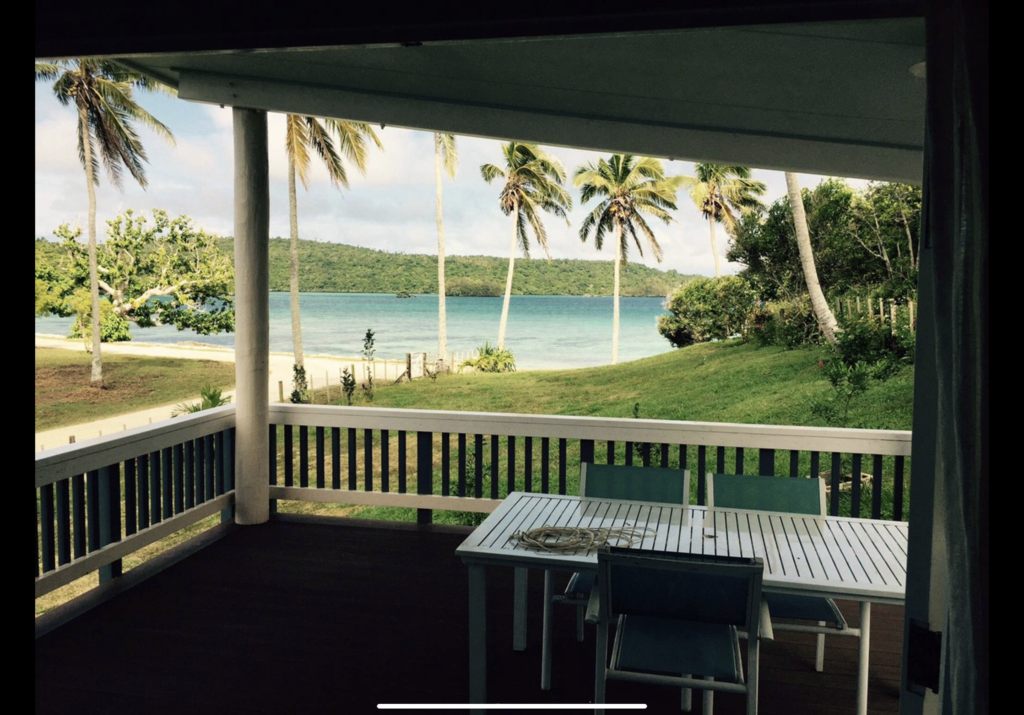
We rented this little cabin and a car for a full two weeks, in hopes we could afford ourselves a few days off from the grueling decommissioning process to take some drives and enjoy some places on land we hadn’t yet visited. One of those places was Ene’io Beach Botanical Garden, run by the retired Minister of Agriculture for all of Tonga. He used the land given to him by the King to build a lovely botanical garden, showing off the trees and plants native to Tonga as well as unique species from other exotic locales. It was huge, with wide paths named for various benefactors meandering off in every direction.
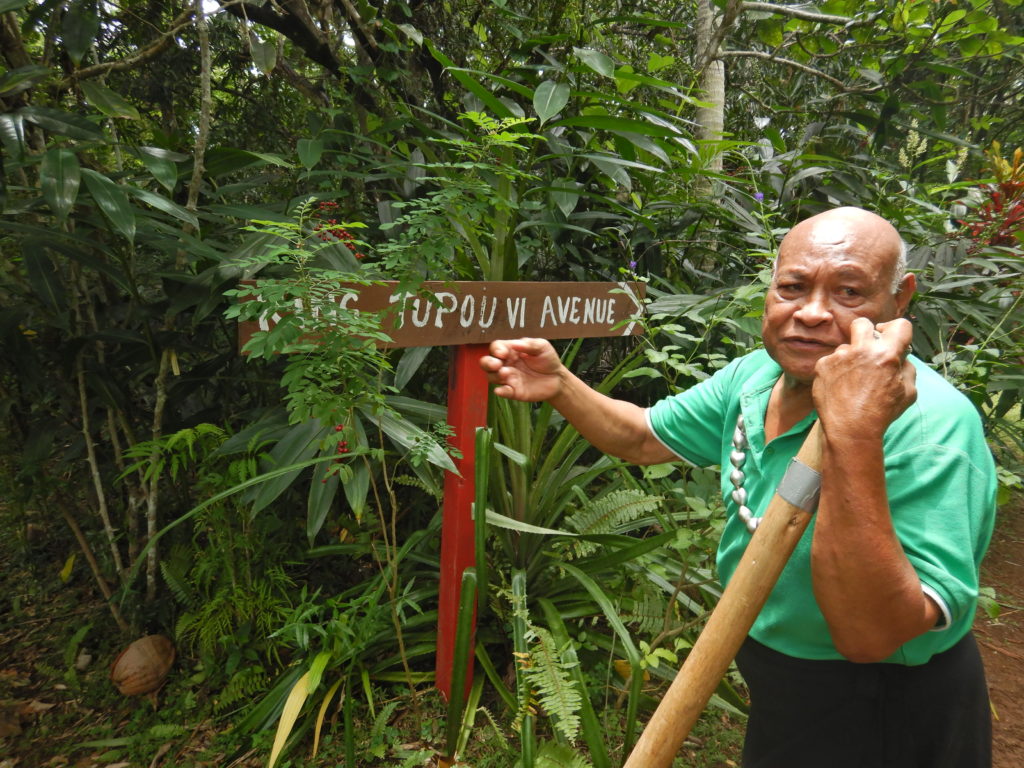


We also drove nearly everywhere we could drive, even across from one island to the next when there were causeways available. Here is a little video of one of the villages we drove through regularly on our way “home” each night.
We also managed to go shopping for souvenirs before we left, something we like to keep to the end so we have had a chance to see everything first. One of the craft specialties in Tonga is painting on bark paper called Tapa, with the paper handmade by the artist. We bought a wall hanging of a mother and calf whale, signed by the artist, and it was the artist in the market who was selling it to us! Here is a picture of me and the artist, with the painting hung behind us, to my left.

Finally, Cool Change was all ready to be left in the competent hands of the Boatyard for six months. We had taken everything off the deck that could be removed; we covered all the plastic deck fittings with aluminum foil to protect them against sun damage; we covered the cap rails with our sunbrella covers, and we covered the whole boat with sunshades to makes it cooler inside; we removed and marked all the lines and replaced the halyards with sacrificial lines. Inside, all the pots, pans, utensils, plates, cups and glasses were washed and bagged; all the perishable food and all the grains and starches were eaten, given away or thrown out – almost all that was left were cans, and even those were bagged in case they burst from the heat; all the books and papers were bagged to minimize mildew; all the teak was washed with vinegar to keep down the mildew, and all the surfaces and lockers (cupboards) were cleaned of any dirt or residual food particles to minimize the chance of insects or rodents making a home there. We rigged an extension cord through the aft chain locker to power a small dehumidifier, which drained through the sink. The list was endless, but finally, end it did.
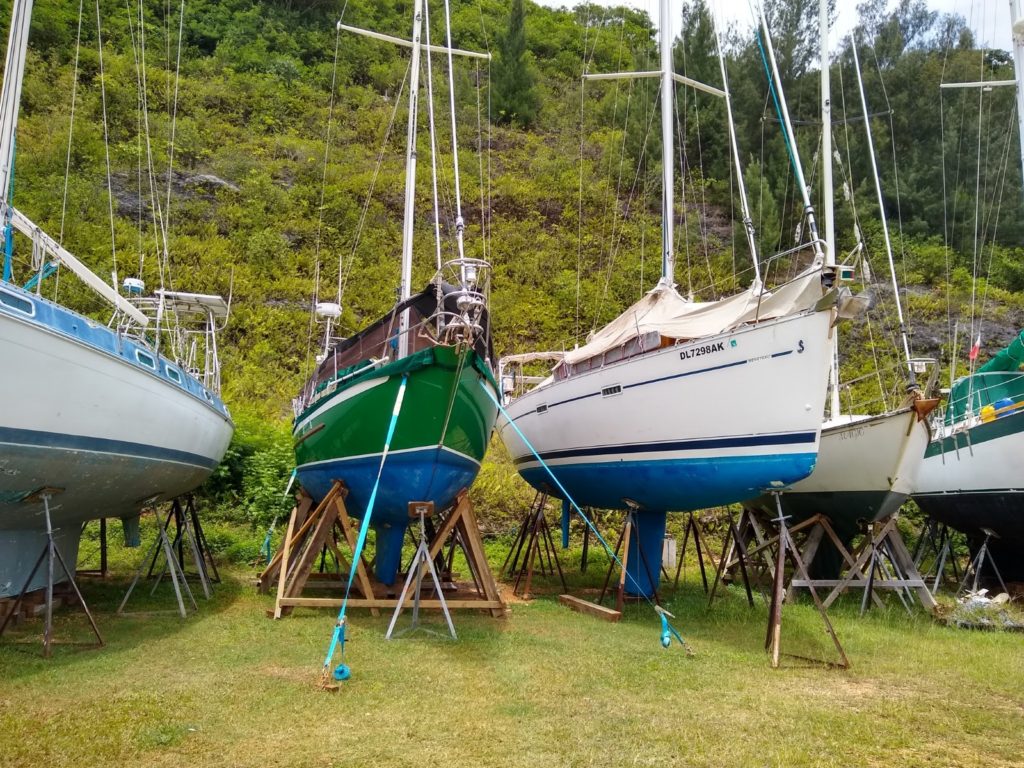
We flew out of Vava’u a day before our connecting flight left from Nuku’alofa, the capital city of Tonga, on the recommendation of Real Tonga Airlines, who advised that flights are often rescheduled or cancelled, so scheduling an early flight the day before is always wise! It was on time, so we had a full day to discover Nuku’Alofa. About 70% of the Tongan population, or about 70,000 people, live on the island where Nuku’Alofa is located, called Tongatapu. And yes, it is clearly more populated, and if you are in search of something you haven’t been able to find anywhere else in Tonga, you can find it here, if anywhere. But still, the “downtown” is all low rise buildings and its entirety is easily walkable. We found a few cute, modern coffee shops, several restaurants, a bookshop where we bought a book on Tongan herbal remedies that was recommended by the Botanical Garden, and the King’s Palace, where we took some pictures.
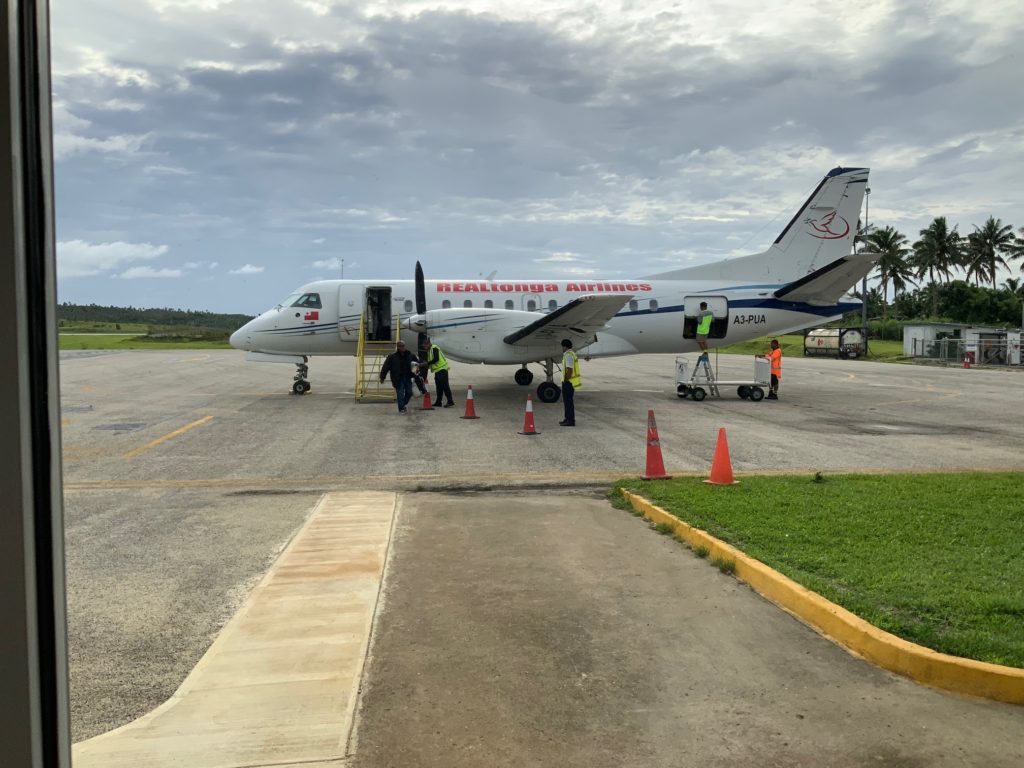
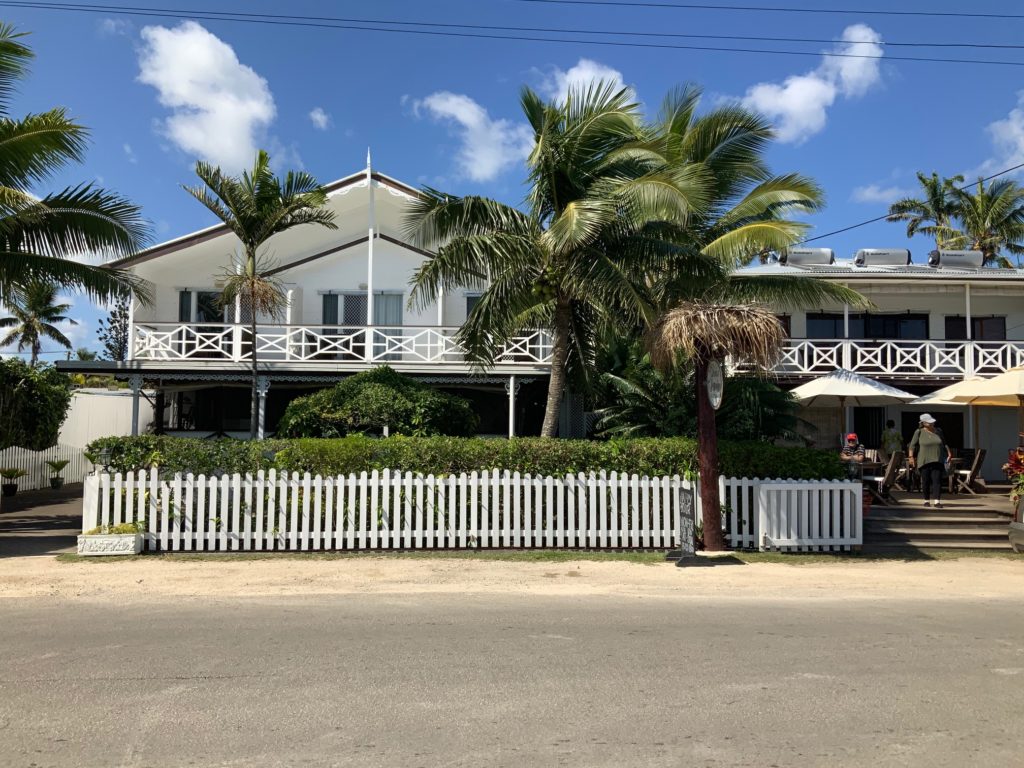


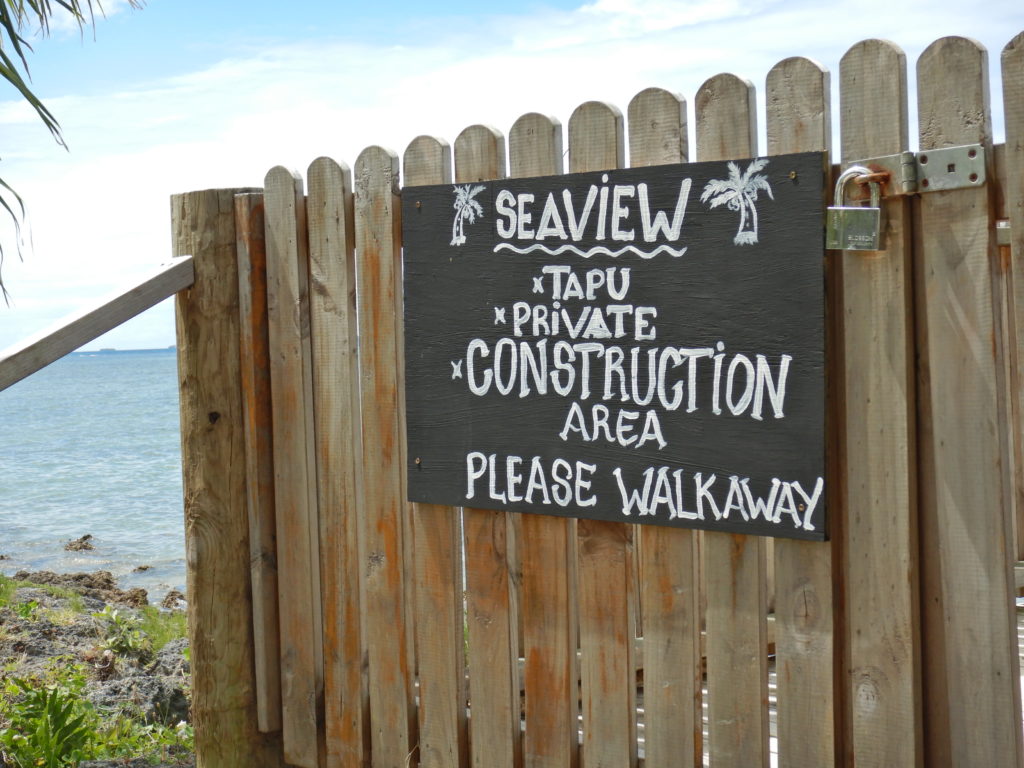
Well, that concludes our journey in Tonga for 2019. We are now home in Coloma, California, enjoying the cool, fall weather; the colors; the river; our hot tub; our friends and family; and so much room! It is nice to be home, but we are also looking forward to, and preparing for, our return to Tonga next May, and our continuing voyage across the Pacific to Australia.


Great blog Cindy… and what a fabulous pic your son took of the whale! Swimming with them …an experience you will never forget. I didn’t like that part about the shark… I assume that is very rare thing!
Hello Cindy,
This is Phil from your French class last year, remember?
From time to time I have visited this site to check our your epic voyage. How I envy and admire your far flung adventures! Fantastic!
Take care
That was an awesome adventure! Love you both!